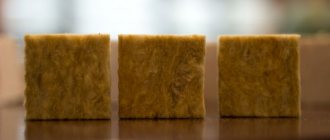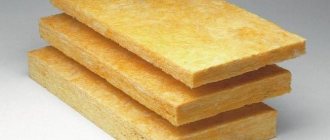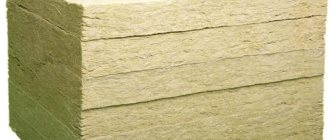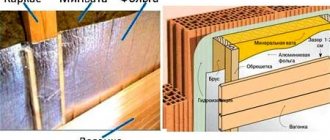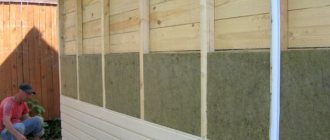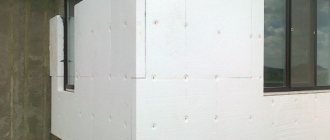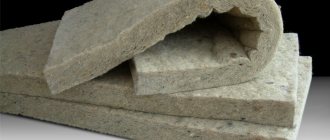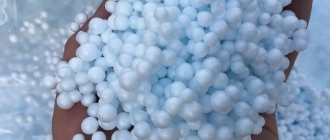It’s not for nothing that they say that the most important thing is the weather in the house. Or rather the microclimate. After all, no one wants to spend extra money on heating, freeze, or fight mold and mildew in the house. Therefore, you need to correctly select the insulation and its characteristics. Today we are talking about the density of mineral wool for wall insulation.
In general, mineral wool, or simply mineral wool, has several varieties. The most popular type of insulation is basalt. They are often perceived as synonyms. I don't see anything terrible in this.
The material received different ratings from consumers. It also happens that a person carries out insulation himself. But eventually the wall begins to collapse, or the room is still cold. Because of this, a person thinks that the reason is the low quality of mineral wool, as well as its unsuitability for use.
Such situations cannot be called rare. Moreover, the reason is usually not that the laying technology was violated, or the wall was not properly prepared. The issue is precisely the incorrect choice of characteristics. We are talking about density and thickness.
Density options
Basalt wool is used for insulation of private houses. It is widespread due to its ability to withstand high temperatures and easy installation. It is made from gabbro-basalt rocks by drawing out thin threads.
Fibers obtained during hot production are laid out in a chaotic manner and pressed. Thanks to this arrangement, basalt wool retains heat well.
When insulating ventilated facades, mineral insulation of varying densities and thicknesses is used. To obtain products of different densities, manufacturers adjust the compaction density of the strips. They are then cut into the required sizes. In construction stores you can find mineral insulation materials with a density of 35 to 200 kg/m3.
Features and benefits
Mineral wool is a fibrous slab with dimensions of 60x120 and 50x100 cm. The thickness of the products is 5, 10 and 15 cm. Ten-centimeter slabs are the most in demand. This thickness is sufficient for using the material in harsh climatic conditions, under the influence of negative temperatures and large amounts of precipitation.
The fiber density of facade slabs is slightly higher than that of the material intended for interior decoration and corresponds to 130 kg/m3. The high density and elasticity of mineral wool are necessary conditions for its installation under plaster. The slabs must withstand the weight of the applied solution and retain their original qualities when it dries.
Due to the fact that most of the country is located in a cold climate zone, mineral wool is in high demand in the domestic building materials market.
The popularity of the material is due to a number of undeniable advantages:
- The excellent heat and sound insulation properties of wool guarantee heat retention at temperatures below 30 degrees, and reliably protect the home from street noise;
- High fire resistance and non-flammability of the material guarantee complete fire safety of the slabs, which begin to melt only at a temperature of 1000 degrees;
- Rodents, insects and other pests do not show interest in mineral wool, so their appearance in it is excluded;
- Excellent vapor permeability promotes moisture removal and rapid elimination of condensation;
- Resistance to moderate mechanical stress significantly increases the service life of the facade, and makes the use of cotton wool preferable to the use of polystyrene foam;
- The absence of the need for additional thermal insulation of interpanel seams solves the problem of heat loss in large-panel buildings;
- The low cost and availability of the material make it possible to finish large areas at minimal cost.
The disadvantages of mineral wool include the presence of formaldehydes in its composition, which have a negative impact on the health and well-being of others. When purchasing, you need to make sure that you have a certificate of conformity and markings from the regulatory authority. This will help avoid purchasing low-quality products and will guarantee the safety of raw materials.
Mineral wool installation work must be carried out using personal protective equipment. The disadvantages include the need to treat the slabs with a hydrophobic compound. If this is not done, the cotton wool will absorb moisture and lose its thermal insulation qualities.
Mineral wool is produced in three modifications, which differ in composition, purpose and performance characteristics.
- Glass wool. Made from sand, soda, borax, dolomite and limestone. The fiber density corresponds to 130 kg per cubic meter. The material is able to withstand heavy loads, has a thermal resistance limit of 450 degrees and thermal conductivity of up to 0.05 W/m3.
Areas of application of insulation based on basalt fiber
Basalt slabs are used for insulation of building facades, partition structures, floors, roofs and other building structures. In addition to residential buildings, basalt insulation is used on industrial sites. Most often used for insulating frame houses.
Having studied the technical characteristics, it is easy to come to the conclusion that mineral insulation can be used in almost all areas of construction. Due to its fire resistance, it is recommended to be used when insulating a building that requires a high degree of fire safety.
Low water absorption makes it possible to use insulation when insulating a bathhouse or sauna. When choosing, remember that the weight of basalt insulation exceeds the weight of polystyrene foam or mineral wool.
Insulation properties
Among the advantages of thermal insulation fiber, the following should be highlighted:
- Basalt is a non-combustible material, which makes it possible to install it on fire-hazardous buildings.
- The heat and sound insulation qualities of the mats also have a sufficient level. This quality gives an advantage when installing residential buildings.
- Due to their moisture resistance, basalt slabs are used in the construction of baths and saunas.
- The thermal conductivity coefficient is low.
- Withstands temperature fluctuations and is resistant to frost.
Characteristics of the heat insulator
The main indicators of basalt wool include its density. Material of one density or another is selected depending on the area of its use. Low-density basalt wool used when installing partitions will settle over time, which will lead to a decrease in the quality of thermal insulation.
For horizontal insulation, you can use wool with a low density level, while when installing vertical structures, use a product with a sufficient level of density.
In the production of basalt fiber, adhesives are used that allow the threads to be arranged in a chaotic manner, forming air spaces between each other. Due to the high air saturation, the material has low thermal conductivity.
Hydrophobicity can also be considered another positive property of insulation. This parameter is characterized by poor moisture absorption. The space between the fibers allows air vapor to easily penetrate through the mineral mats. This quality prevents condensation from accumulating inside the material.
Basalt can withstand temperatures up to +500°C, and some specially designed ones up to +1000°C.
Examples of our work on finishing wet facades made of mineral wool
Finishing of the facade in the Gar-Pokrovskoye community center
Finishing of the facade in KP Babenki
Finishing of the facade in the village of Firsanovka, Moscow region
Facade finishing in Antonovka
Thermal conductivity of basalt mats
The thermal conductivity coefficient of basalt wool is in the range of 0.032-0.048 W/mK. The same indicators characterize polystyrene foam, polystyrene, cork and foam rubber.
Important! Mineral mats have replaced asbestos, which is harmful to health, as a fire-resistant material.
Before you go shopping for insulation, consult with friends or knowledgeable people about trusted retail outlets known for the quality of the product. Only this approach guarantees the purchase of good material that meets the standards.
Description of slabs with different density levels
There are basalt slabs of various density levels. This is reflected in the following properties of insulation: vapor permeability, moisture resistance, resistance to high loads and response to compression of the material.
Table of parameters of basalt insulation
Based on density, slabs are divided into the following categories:
- Up to 35 kg/m3 – used for vertical and inclined insulation without load.
- Up to 50 kg/m3 - with the help of such insulation they increase the level of thermal insulation of interior partitions, attics or attics. Where there is no load on the surface.
- Up to 75 kg/m3 – lightly loaded surfaces, under floors when placed between joists.
- Up to 100 kg/m3 – external insulation of industrial and residential buildings.
- Up to 125 kg/m3 – arrangement of ventilated facades.
- Up to 150 kg/m3 – single-layer insulation of reinforced concrete or metal building frames.
- Up to 175 kg/m3 – insulation of heavy buildings with further plastering of the facade. Or it is located inside a three-layer cake.
- Up to 200 kg/m3 - insulation with such a density can withstand the highest loads. The soundproofing qualities of the material are significantly higher than analogues with a lower density level.
Operational period of mineral insulation
Recently, the construction of private houses has become popular. They, like other buildings in our climate, need insulation. To feel confident that the thermal insulation of a private home is at the required level for a long time, it is necessary to select materials that meet these standards.
Mineral wool based on basalt fiber is ideally suited for this task. The service life of this heat insulator, subject to installation rules, is 50 years or more. The advantage of basalt wool over other insulation materials is not only in chemical and physical indicators, but also in price. The quality of the products is also excellent.
Experts in a complex field
The technology for installing suspended ventilated facades, although introduced quite a long time ago, is still considered one of the most effective. In order for the system to serve reliably, its installation should be entrusted to those who have thoroughly mastered the technique of its installation. There are such professionals: these are specialists from Diat Group of Companies, an engineering organization that provides services not only in Moscow, but throughout Russia. Our clients receive the following benefits:
- calculation of curtain facades and insulation;
- careful design, on which the successful implementation of the project depends;
- performing tasks of any complexity;
- a full range of works using quality materials.
GK Diat employees have enormous experience not only in providing design and installation services to the population and business. Our team has many patents, as well as scientific works in the field of building design. We have an individual approach to each client. Contact us, and your idea for insulating facades will become another engineering masterpiece, the creation of which will be assisted by the employees of Diat Group of Companies.
Technology of wall insulation with basalt
Inside with sheathing
Refers to the simplest option for insulating a private home and industrial structures. The essence of the method is to create a sheathing frame. Assembly is made from wooden beams or metal profiles. The width of the mats is first measured and, subtracting 5-7 cm from the obtained values, the sheathing is assembled.
Next, mineral wool is tightly inserted into the cells of the frame, filling the entire space. A vapor barrier membrane must be attached on top of the insulation.
Lathing
Insulation of walls using the “well” method
If the house design involves laying facing bricks, then the best insulation option would be “well”.
Consider the composition of the “well” pie:
- Bearing wall. As a rule, it is brickwork laid out in one row. Although other materials are also used for load-bearing structures. Depending on the required load-bearing capacity, the walls are laid out in half a brick, a brick and a half or two.
- Insulation. In this case, basalt wool is used. Fastening to the surface is done using umbrella dowels.
- Facing wall. Masonry begins after complete installation of the insulation or as the inner layer builds up. Ceramic or silicate brick is used as the outer layer. The usual installation method is half a brick. A prerequisite for laying facing bricks is the presence of a concrete base.
- Ventilation gap. Since the appearance of condensation on the inside of the insulation is undesirable, a ventilation gap is created for this purpose to ensure sufficient ventilation.
Well method
Attention! If for some reason it is not possible to create a ventilation gap, then it is better to abandon the well method of insulation altogether. This applies to mineral wool.
Wet insulation of walls
The method is used for plastering, because with the “wet” method of insulation, lathing is not provided. Since a high load will be applied to the mineral wool, it is recommended to use high-density mineral wool.
Wet method
Basalt wool fastening technology:
- Following the instructions supplied by the manufacturer on bags of glue, we prepare a liquid solution.
- Apply the prepared mixture onto the mineral coating with a notched trowel. The glue is applied in a continuous layer without coating the end part, which can lead to a decrease in the level of thermal insulation.
- We install mineral mats on the basement of the building and press them against the wall. To increase adhesion, it is necessary to smooth the surface using pressing movements, applying little force. Installation of basalt wool is done from bottom to top. The next row is laid with an offset of half the mat. The same applies to places near window and door openings.
- External and internal corners are reinforced with plaster corner plates.
- We fix the mineral wool with umbrella dowels - 5 fasteners per sheet.
- Using an adhesive solution, we attach the reinforced fiberglass mesh. Make sure that the material overlaps each other by 15-20 cm.
- At the final stage, plastering is carried out.
Frameless method of insulation from the inside
The frameless installation method refers to the wet fastening method. To complete this task you will need an adhesive solution and a cleaned wall surface. The mortar is applied directly to the wall using a notched trowel. Next, a mat of stone wool is applied. To improve the quality of adhesion, umbrella fasteners or self-tapping screws are used, depending on the type of coating.
Installation of mineral wool on a ventilated facade
This method requires the assembly of the sheathing, as it involves the installation of facing material.
Ventilated facade
Warming process:
- The sheathing structure is assembled taking into account the width of the mats.
- Mineral mats are laid at random.
- Next we move on to attaching the windproof membrane.
- For further fastening of the cladding, a counter-lattice is assembled from 50x50 mm slats.
At the final stage, façade finishing work is carried out.
Insulation of the wall of a frame house
Thermal insulation of a frame house differs in that it involves the installation of slabs inside the walls, and on the inside and outside of the building. As a rule, manufacturers of frame buildings create walls with a thickness of about 15 cm, which allows you to place 3 mats of 5 cm each. It is also possible to combine wool of different thicknesses - 10 cm and 5 cm. If it is necessary to carry out finishing work on the facade of the building, lathing is assembled on top of the insulation.
Thermal insulation of a frame building
Review of the best thermal insulation options
The required material must combine lightness, good insulating properties, resistance to moisture and external influences, and durability. Preference is given to rigid slabs that retain their shape unchanged throughout their entire service life, ideally non-flammable. Stone wool and polystyrene foam of different brands have qualities suitable for facades; for general purposes, they have slightly different installation and finishing technology. The cake scheme includes three main layers: slabs, reinforced mesh and plaster mortar, the latter can combine the function of protection and decoration or, conversely, require additional painting.
The advantages of polystyrene foam include a closed cell structure, moisture resistance, low density, easy installation and affordable cost. The maximum effect is achieved by using specialized locking and tongue-and-groove systems with milled external surfaces that eliminate the formation of cold bridges and better adhere to the plaster. TechnoNIKOL Carbon, Penoplex Facade and their analogues have suitable characteristics, but if necessary, ordinary brands (PSB, Knauf) with a density of 25 kg/m3 are also suitable. The disadvantages of this option include not the best resistance to mechanical damage, flammability and the need for additional fasteners and mesh reinforcement.
The use of basalt wool for façade insulation followed by plastering is chosen if there is a desire to maintain the permeability of wall materials or high fire safety requirements. In this case, not just any type of mineral wool is suitable: for obvious reasons, they must be hydrophobized, the required minimum density is 130 kg/m3: the stiffer they are, the better. In order to reduce the load on the foundation, specialized grades can be used - lightweight on the one hand, rigid and designed for applying mortar on the other.
The moisture resistance of such basalt slabs is enhanced due to the special arrangement of fibers and impregnation with special compounds; a small part of the absorbed sediment is not retained inside. Despite the higher adhesive strength than smooth foam, it still needs a reinforced mesh, in particular, when covering the main facade plaster with a finish of a different brand and/or in order to increase the strength of the outer layer.
The considered disadvantages of stone wool include deterioration in insulating properties during operation and a slightly worse thermal conductivity coefficient compared to polystyrene foam. This insulation is more expensive and places a higher load on foundation structures.
Comparison of main characteristics:
| Indicator name | TechnoNikol | |
| Basalt slabs Technofas | Extruded polystyrene foam Carbon Eco (for facade and plinth) | |
| Thermal conductivity coefficient, W/m°C | 0,038-0,041 | 0,034 |
| Material density, kg/m3 | 140 | 30 |
| Compressive strength, kPa | 45 | 250 |
| Temperature range of application, °C | -60 to +200 | From -70 to +75 |
| Vapor permeability coefficient, mg/m h Pa | 0,3 | 0,011 |
| Flammability group | Ng | G4 |
The main criteria when selecting a specific type are the material and load-bearing capacity of the base, safety, installation costs, compatibility with the selected plaster mixture and expected service life. In terms of compliance with fire standards, ease of fastening and maintaining the permeability of walls, stone wool definitely wins. In terms of price, lightness, moisture resistance and durability - polystyrene foam. The operating conditions of the thermal insulation layer play an important role - for the base and areas close to the ground, you should buy an option with a closed structure; compacted foam plastic has suitable characteristics.
Recommendations for insulation
The maximum effect is observed when placed in two layers with jointed seams; this design eliminates the formation of cold bridges. Fiber insulation under wet plaster is protected from ground moisture, the bottom slabs are installed on a special base profile. Fastening is carried out using glue; polystyrene foam is additionally fixed with disc-shaped dowels. In stressed areas (corners, openings, expansion joints, junctions with the roof), both types are protected with special profiles; in addition to maintaining the required level, they enhance the quality of adhesion to the mortar.
In order to improve the performance of thermal insulation and reduce costs when implementing it, a number of recommendations are followed:
